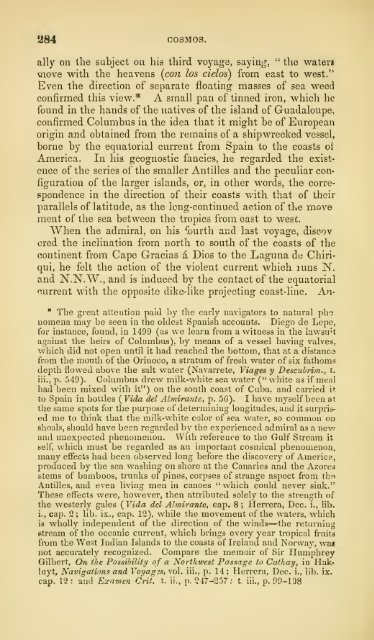See the complete document here
See the complete document here
See the complete document here
Create successful ePaper yourself
Turn your PDF publications into a flip-book with our unique Google optimized e-Paper software.
284 COSMOS.<br />
ally on <strong>the</strong> subject on his third voyage, sayin^j, " <strong>the</strong> waters<br />
010ve with <strong>the</strong> heavens {co7i los cielos) from east to west."<br />
Even <strong>the</strong> direction of separate floating masses of sea weed<br />
confirmed this view.* A small pan of tinned iron, which ho<br />
found in <strong>the</strong> hands of <strong>the</strong> natives of <strong>the</strong> island of Guadaloupe.<br />
confirmed Columbus in <strong>the</strong> idea that it might be of European<br />
origin and obtained from <strong>the</strong> remains of a shipwrecked vessel,<br />
borne by <strong>the</strong> equatorial current from Spain to <strong>the</strong> coasts oi<br />
America. In his geognostic fancies, he regarded <strong>the</strong> existence<br />
of <strong>the</strong> series of <strong>the</strong> smaller Antilles and <strong>the</strong> peculiar con-<br />
figuration of <strong>the</strong> larger islands, or, in o<strong>the</strong>r words, <strong>the</strong> correspondence<br />
in <strong>the</strong> direction of <strong>the</strong>ir coasts with that of <strong>the</strong>ir<br />
parallels of latitude, as <strong>the</strong> long-continued action of <strong>the</strong> move<br />
ment of <strong>the</strong> sea between <strong>the</strong> tropics from east to west.<br />
When <strong>the</strong> admiral, on his ^ourth and last voyage, disco v<br />
ored <strong>the</strong> inclination from north to south of <strong>the</strong> coasts of <strong>the</strong><br />
continent from Cape Gracias a Dios to <strong>the</strong> Laguna de Chiriqui,<br />
he felt <strong>the</strong> action of <strong>the</strong> violent current which luns N.<br />
and N.N.W., and is induced by <strong>the</strong> contact of <strong>the</strong> equatorial<br />
current with <strong>the</strong> opposite dike-like projecting coast-line, A;i-<br />
* The great attention paid by <strong>the</strong> early navigators to natural ph'?<br />
nomena may be seen in <strong>the</strong> oldest Spanish accounts. Diego de Lepe,<br />
tor instance, found, in 1499 (as we learn from a witness in tlie lawsuit<br />
against <strong>the</strong> heirs of Columbus), by means of a vessel having valves,<br />
which did not open until it had reached <strong>the</strong> bottom, that at a distance<br />
from <strong>the</strong> mouth of <strong>the</strong> Orinoco, a stratum of fresh water of six fathoms<br />
depth flowed above <strong>the</strong> salt water (Navarrete, Viages y DescubHm., t.<br />
iii., p. 549). Columbus drew milk-white sea water (" white as if meal<br />
had been mixed with it") on <strong>the</strong> south coast of Cuba, and carried i^.<br />
to Spain in bottles ( Vida del Almirante, p. 56).<br />
I have myself been at<br />
<strong>the</strong> same spots for <strong>the</strong> purpose of determining longitudes, and it<br />
surprised<br />
me to think that <strong>the</strong> milk-white color of sea water, so common on<br />
shoals, should have been regarded by <strong>the</strong> experienced admiral as a new<br />
and unexpected phenomenon. With reference to <strong>the</strong> Gulf Stream it<br />
self, which must be regarded as an important cosmical phenomenon,<br />
many effects had been observed long before <strong>the</strong> discovery of Americ?.,<br />
produced by <strong>the</strong> sea washing on shore at <strong>the</strong> Canaries and <strong>the</strong> Azores<br />
stems of bamboos, trunks of pines, corpses of strange aspect from thr?<br />
Antilles, and even living men in canoes "which could never sink."<br />
These effects were, however, <strong>the</strong>n attributed solely to <strong>the</strong> strength of<br />
<strong>the</strong> westerly gales ( Vida del Almirante, cap. 8 ; Herrera, Dec. i., lib.<br />
i., cap. 2; lib. ix., cap. 12), while <strong>the</strong> movement of <strong>the</strong> waters, which<br />
is wholly independent of <strong>the</strong> direction of <strong>the</strong> winds— <strong>the</strong> returning<br />
stream of <strong>the</strong> oceanic current, which brings eveiy year tropical fruits<br />
from <strong>the</strong> West Indian Islands to <strong>the</strong> coasts of Ireland and Norway, wa«<br />
not accurately recognized. Compare <strong>the</strong> memoir of Sir Humphrey<br />
Gilbert, On <strong>the</strong> Possibility of a Northwest Passage to Cathay, in Hak*<br />
luyt, Navigations and VoyagBs, vol. iii., p. 14 ; Herrera, Dec. i., lib. ix.<br />
cap. 12: and Examen Crit. t. ii., p. 247-257; t<br />
iii., p. 99-108
















